Toddler Discipline Basics: a Complete Framework
Best Practices for Long Term Success in Parenting
Welcome to the toddler behavioral series! We’ve broken down the topic of discipline into two articles. The first one (this one) covers basic background principles — it lays out some best practices you can rely on all the time. The next article is a tactical, how-to run-down of what you can do when everything falls to pieces and you’re about to fly off your rocker. (And you can also read more about spanking in particular, and why we’re not on board with it.)
Discipline is a touchy subject. It tends to divide people – partners, parents, grandparents, friends, siblings.
We don’t want to do that.
We’re not here to tell you how to raise your kids. Instead, we want to share some overarching best practices that — when used consistently – (usually!) help keep the peace, regardless of which “technique” you choose. Think of it as a framework for managing toddler behavior.

Whether you believe in attachment parenting, permissive parenting, hands-off parenting, authoritative parenting, military-style parenting — or you’re like us and don’t have time to think about what “style of parenting” you subscribe to (LOL) — we think you’ll find some useful principles and concepts here.
We’ve combined our experiences with the wisdom and writing of top experts in psychology, psychiatry, child development, and pediatrics to put together a list of fundamentals.
These are things that anyone-and-everyone who cares about discipline agrees on, broadly speaking. We can debate particulars all day, but these “ground rules” are pretty widely sanctioned by people who have made this their life’s work.
Also, check out our favorite parenting books on discipline/behavior.
Before We Begin…
A Few Words on “Discipline”
Almost everyone who studies or writes about discipline actually hates the word “discipline.”
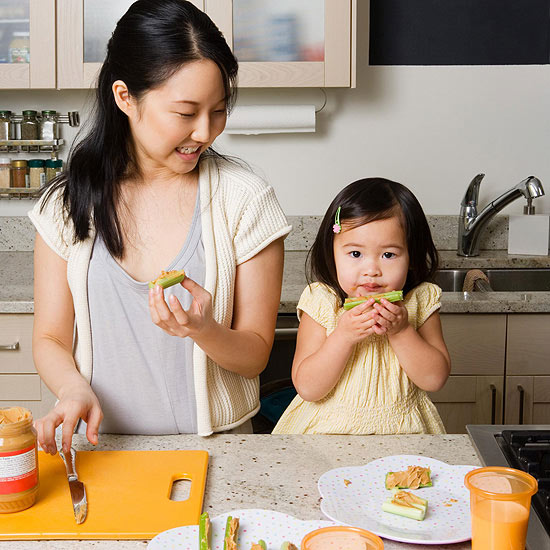
Today’s parenting experts invite us to think about discipline much more broadly – as a “way of life” or a way of educating our kids (originally, the definition of the word “discipline” had to do with teaching), instead of a way of responding to problems.
Discipline entails the mundane nuances of everyday life – how we speak to our children, how we eat, how we interact with others, how we carry ourselves. It should be an “all-the-time” kind of thing, rather than something that “happens” in response to particular triggers.
As many of us joke with our diets… “it’s a lifestyle.”
For many parents, “discipline” conjures up negative associations with punishment, misbehavior, consequences, and anxiety — nuns, belts, paddles… you name it. Let’s face it, many of us were spanked as kids… or worse.
Now that WE are parents, some of us have sworn off spanking and gone in the complete opposite direction when it comes to disciplining our own kids (more on that in a bit), but others rely on what’s familiar to them from their own upbringing.
We cover spanking elsewhere in more detail, but here we at least want to say that spanking is problematic since it models the exact kind of behavior we’re trying to get our kids to stop doing. Also (spoiler alert!): it doesn’t “work.” Instead, we’re sharing strategies that are held up by research, experts, and parents as productive, effective, and considerate. Bottom line: you won’t see spanking — or any other form of corporal punishment — recommended here.
As Daniel J. Siegal and Tina Payne Bryson remind us in The Whole Brain Child and No-Drama Discipline, kids don’t have fully formed brains; that’s why they’re always changing. And these experts also underscore the importance of adapting discipline to a child’s age, abilities, strengths, and weaknesses: “when we discipline, we must always consider a child’s developmental capacity, particular temperament, and emotional style, as well as the situational context.”
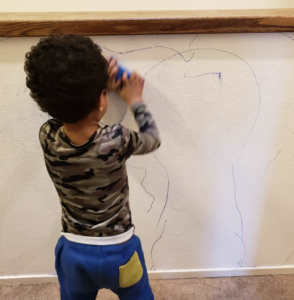
This also reminds us of why it’s SO important to have realistic expectations about your child’s behavior (and the reason we decided to craft separate pieces about one-, two-, and three-year-olds). Remember, you are the best expert on your child; we’re just here to share some generalities.
Remember that context applies to us parents, too… you know how you’re sometimes just having “one of those days”? You know what it’s like to feel overtired, hangry, stressed, or overwhelmed?
Just like you are not always a stellar parent, your kids are not always at their best either. Their behavior isn’t always consistent. Just because your child responded poorly (or well) to something once doesn’t necessarily indicate how he’ll handle the same situation tomorrow.
And lastly… all kids are different. We know. Parenting isn’t a one-size-fits-all enterprise. To be honest, some kids are just “easier” than others, some kids are more “spirited” than others, and some kids tend to be downright difficult. Do yourself a favor: don’t play the comparison game — and don’t beat yourself up if your defiant kiddo isn’t as obedient as your neighbor’s.

To recap, remember:
- Discipline – or “managing behavior” — isn’t about inflicting punishment; it’s a wholesale approach to parenting (or, as we say in the south, “child rearing”).
- Your approach should be appropriate to your child’s developmental stage.
- Context matters.
- Every kid is different.
Prevention is the Best Medicine
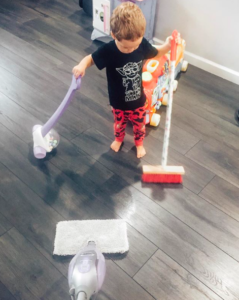
Before we really get into the nitty-gritty in our next segment, we want to talk about some general best practices. Background stuff. Preventing sh*t from going wrong in the first place.
Experts refer to prevention as the “first line of therapy” in discipline. Prevention. Is. Everything.
Everyone wants to talk about what to do when something goes wrong, but the truth is that spending time and energy making sure things don’t go wrong in the first place is far and away your best investment. Sure, this won’t work for everything, but if it takes some of the load off, then GOOD. Avoiding problems is waaay easier than responding to them.
With small children, there are several key strategies for prevention, ranging from very tactical and achievable to quite abstract and elusive. We’re calling these our “best practices”; here goes, gang…
Discipline Best Practices – Prevention of unwanted behavior (vs. reacting to it)
These are our discipline best practices — those things we can and (ideally) should be doing all the time, as much as possible.
Here’s the cheatsheet, with details to follow.
Pick the things that are important to you, and set clear boundaries for what’s acceptable.
Follow your own rules regularly. Be consistent and be predictable.
Be calm, be kind, be patient, be generous. Show your kiddo what being a good family member and community member looks like.
Assume everything will take you longer than planned — always — and plan accordingly.
Develop routines. Grow them, love them, live them.
Help kids feel some sense of control and autonomy by offering them (2) choices for decisions you don’t care about.
You got it!
Remember that you’re not speaking to an adult, and be mindful of the ways your words can influence your interactions with your child.
And — most importantly:
Maintain your composure — slow down. Breathe, mama.
Oh shoot, and let’s not forget:
Practice your own brand of self care as often as possible.
OK — now let’s dive in.
1. Childproof Zealously
Which is easier? Prying the waffle-maker from your kiddo’s hands after you find him toting it around like a toy puppy, or keeping it locked in the cabinet from the start?
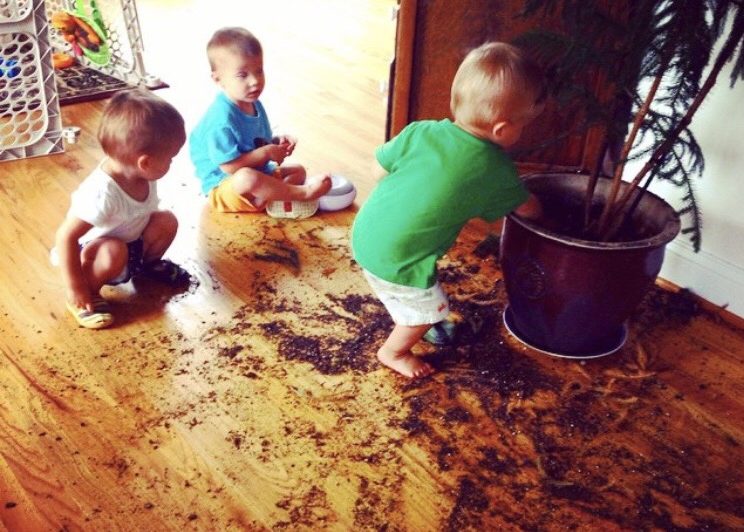
“Household engineering” is an easy way to ward off trouble before it even starts. Feel out what works for you — every kid’s needs for this will inevitably be different — but don’t ignore this strategy and invite temptation. When in doubt, it’s better to overdo it than underdo it; this way, you won’t have to constantly say “no” to your kids. If you need some help, check out our childproofing recommendations.
2. Establish firm limits
Setting firm, clear boundaries is a point of unanimous agreement among parenting experts. Where you set those boundaries is up for debate, but having them is a must! Every family’s boundaries are different.
It’s counterintuitive, but as psychiatrist Robin Berman explains in her book Permission to Parent: “kids with too much power feel unsafe. Children with too much influence often become anxious because they feel like they have to control their environment, and they really don’t know how.”
For busy parents, it’s easy to let time get the best of them without stopping to really think about where the boundaries should be drawn and then communicating those boundaries/rules to their kids. Many times, it’s because we really haven’t had the time to put much thought into it until it becomes a problem. Or sometimes, we know the rule, but we bend it because it’s easier in the moment (guilty!).

Many working parents fall victim to this every day: we tend to feel guilty for not being around enough — and when we are, we don’t want to be the “bad guy,” so we don’t establish and enforce limits. This can ultimately lead to a more chaotic and highly-charged relationship between parent and child.
For example, my friend tells me that when her husband comes home at the end of the day, her kids fall apart. Her husband’s excited to see them and play with them — understandably — but he gets the kids totally amped up right before bed, and all the rules get tossed out the window. He lets them run on the couch, caves when they ask for sugary snacks, and doesn’t follow the bedtime routine.
Of course, this parent has the best intentions: he wants to enjoy time with his children (and maybe — deep down — is trying to make up for lost time). But letting the kids run wild sends a strong signal that he doesn’t enforce boundaries. Kids learn this quickly, and – consequently – he will likely have a very difficult time trying to enforce any rules going forward, especially if he’s alone with them.
Lesson learned: don’t let guilt (and believe me, we all have it!) get in the way of establishing and enforcing boundaries. Bottom line: being a pushover with your kids will make your life harder, not easier, and your kids won’t “like you more” for it. They need boundaries.
If you’re not big on limits, OK. We get it. But especially for the really important stuff in your life, at least consider setting some boundaries. Then don’t budge on them (see #3). Try your hardest not to adjust these limits based on your mood, the presence of other people, or the fact that you are in public.
Limits are limits, but deciding where to set your kids’ limits is YOUR choice.
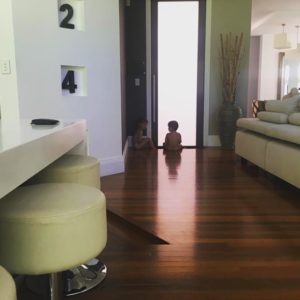
*Note: this is where we think it’s really important to pick and choose your battles. Decide what really matters to you, and set firm limits for those things. (And know that those things might be completely different for you vs. your neighbor vs. your brother. That’s fine.)
Ask Yourself: Do you care?
I started to correct my son when he was putting his shoes on the wrong feet. He quickly became quite upset, which of course led me to become all the more insistent. But after taking a deep breath, I was able to step back and let him go through with it. Because I didn’t really care if his shoes were on the wrong feet.
There are TONS of examples of this — when we say “pick and choose your battles,” we know very well that we’re all going to have different ideas about what this means. It’s all about deciding what you care about:
– Many parents feel differently about standing on furniture — some don’t care if their kids traipse up and down the couch while others are steadfast against it.
– We don’t care if our kids climb up the slide at the playground, but some parents feel like it’s tantamount to breaking the law.
– Meg has a rule against leaving the house in pajamas, but Brit’s kids barely even wear “normal clothes” out of the house.
– For some of us, food is only allowed in the kitchen (or even only at the table), but others of us are fine with bringing a snack to the living room.
– Take your shoes off when entering someone’s house? Some people are adamant about this, others don’t care.
*The point is, pick what you feel strongly about, and set a firm limit for it. And for those boundaries, commit to enforcing them, all the time.
And make sure you tell the rules to your kids!
Don’t laugh, but sometimes I’ll get upset with my kiddo for violating a house rule, then stop and remember that I really didn’t put any effort into telling her about the rule in the first place. Sometimes we take for granted that kids should inherently understand basic rules, like no drawing on the walls, but at young ages, they really don’t. Think about it this way: why is drawing on the wall that different than drawing on paper? Why can I stand on a stool but not a chair? Assume your little kids know nothing about the world (because most times, they don’t!).
An exercise: carve out some time to sit down and write out a handful of rules for both in and out of your house. Choose the things that are really important to you — the things that cause the most trouble. Discuss the rules with your partner — make sure you’re in agreement.
Later, carve out some quiet, uninterrupted time to discuss them with your kid(s). Get down on their level (call a “family meeting” and sit down on the carpet in the kid’s bedroom, much like in circle time.) Tell the rules to your kids — you’ll be surprised how amenable they’ll be! See if they have any questions. When you’re done, there should be no confusion about what the rules are. You might even see them policing each other — it’s really great, HA.
3. Stick by your word (be consistent)
No matter what the discipline policy in your home, it’s going to work better if you follow it consistently. As experts at the Gesell Institute say in their book Child Behavior: “Generally the most successful parents are those who are able to maintain a firm and consistent policy of discipline, and who can be counted on to stick to what they have said.”

Another way of thinking about this is to follow through — implement the consequences you declare, and stick to your own rules.
Do not make empty threats.
Do not change your tune based on external circumstances.
Consistency can be downright painful in social situations. It’s really tough to stick to your rules when you’re at the playground, with a playgroup, or hanging out with your siblings’ families, because — as we mentioned — everyone has different rules.
It’s hard to stand by your “no junk food” rule when your sister’s kids are chowing down on chips and M&Ms. It’s exasperating to make sure your three-year-old holds your hand on a walk, while she watches your friend’s six-year-old walk independently. It’s disheartening to enforce bedtime when your child’s watching her neighbors continue playing outside.
Similarly, sticking to your rules even just in everyday, ordinary situations is really hard. It’s sooo inconvenient sometimes. Indeed, we often stand in our own way when it comes to discipline, because it is so difficult to always respond in the same way. I can’t tell you how many times I pretend I don’t see something because I just don’t feel like responding to it.
Often, we have to suffer from the consequences too.
That’s right. Grounding your child means that you have to stay home with him and can’t socialize at the neighborhood BBQ; telling your child that he cannot have one of the candy bars displayed near the checkout counter will undoubtedly get you major public meltdowns and a few dirty looks.
But guess what? Once your little one realizes that candy bars on his way out the grocery store are never an option, he will learn to stop asking. (“The rule is we don’t buy treats at the check-out line.”)
We’ll be the first to admit: consistency is SUPER difficult, and it’s easy to cave in, but being consistent with your rules and boundaries will definitely pay off in the long term. You’ll be thanking yourself later for doing the hard work of consistently enforcing your boundaries.
When kids cry/whine/beg/badger — and sometimes get their way (they get a treat, they get picked up, they (ultimately) get what they’re after), that bad behavior keeps getting reinforced.

Similarly, when kids know the outcome will be different every time they push a boundary, they will continue to try using whatever means worked the last time. They may even up the ante each time (a regular tantrum didn’t work? Let’s try a nuclear meltdown!). They aren’t terrible human beings, they’re simply reacting to the variable reward system, which is the same system that keeps people coming back to the casinos to gamble each time. There’s a chance you might win at the poker table (you have in the past, after all) — and it certainly is fun to try!
I was at the pool recently and a toddler was screaming for a snack from her mom. The grandma turned to the mom (her daughter) and said “just give her a snack so she’ll stop whining.”
No, grandma, NO! Be a friend!
Note that consistency can entail flexibility. You might, for example, have a rule that your kids can’t watch TV or can’t eat dessert at night, but maybe those limits only stand in your house for normal days. Maybe your kids are allowed to watch the iPad at grandma’s, or to have dessert at birthday parties or on Friday nights, for example. There can always be exceptions for special occasions, but you have to state them beforehand, not after your child has begged and negotiated to get something.
Being consistent doesn’t mean you can’t be adaptable — just like you want your kids to be — but the more you can predictably follow through on your rules, the better.
In a similar vein, you’ll likely adjust your rules over time as your child gets older. When my son was 1 or 2, I never allowed him to open the fridge, but by the time he was 3, he was just so excited to help me get things ready for his dinner that I’ve adjusted that rule. Now, the new rule is that he has to ask permission to open the fridge and take things out.
Though consistency is key when it comes to discipline, different caregivers may have different parenting styles. That’s totally OK!
In a nutshell, as long as caregivers support each other and stay consistent individually, kids can learn that they have different rules with different people. This is especially important if you are sharing custody with an ex. Problems arise not as a result of different approaches or rules, but when parents criticize one another or undermine each other’s disciplinary decisions. Managing a small child is tough enough on its own — don’t waste your time trying to manage adults, too. Instead, commit to: always make one another “look good,” consistently follow-through with one another’s decisions, and accept your differences.
One last note here: don’t let your children negotiate. Kids can become surprisingly (and hilariously) adept at this. But when they successfully negotiate (e.g., just one more show, pleeease! One more cookie! Five more minutes at the park!), it encourages them to keep doing it (because their negotiation clearly worked).
This is where many parents get into trouble. Why?
Because we’re tired. How many times have you said to yourself “God, I just don’t have the energy to deal with this kid right now?” Being consistent all the time takes an incredible amount of energy (in the short term!), whether you’re in the mood or not.
Which brings us to… MENTAL FATIGUE.
Being a parent is exhausting. Like, physically, mentally, and emotionally exhausting. And it’s not just the newborn phase that’s so depleting. It’s all of it: the endless to-dos; the overwhelming worry that goes along with keeping small humans healthy and alive; the constant noise (from babies’ crying to kids chattering to the dog barking); the lack of sleep… And don’t get us started on all the decisions that we parents have to make every second of every day — from what to make for breakfast to which line items to cut out of the family budget.
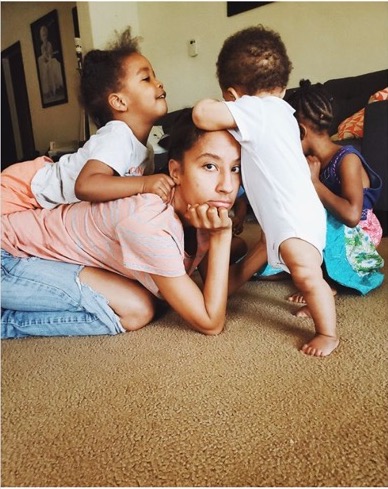
Unlike most every other job, parents don’t get time off — we don’t get to “go home” at the end of the day to relax and rejuvenate. We’re always on and ready for anything — even in the middle of the night. And yes, that’s what we signed up for — that’s just what being a parent to young kids is, but that doesn’t mean it’s not utterly draining.
So it’s no wonder that moms and dads are susceptible to mental fatigue. At the end of the day (which conveniently coincides with the “witching hour,” when our kids are naturally more whiny, difficult, exhausted, hungry, and thus prone to meltdowns), busy parents are so low on mental, physical, and emotional energy that they have no patience left.
Not only that, but many parents also suffer from decision fatigue — which means that each choice they make throughout the day becomes more difficult for their brains to process. As they get too tired to continue considering the many pros and cons of each choice, they have little self-control and willpower left and wind up making more impulsive decisions. (Interestingly, this is why sweets are so often displayed at the checkout line. By the time you’ve finished shopping and making a million choices, you’re mentally spent and your willpower is low; thus, you’re prone to splurge on something that’ll give your body a quick boost — SUGAR!)

All of this combined makes parents more apt to give their children whatever they want to make them happy, calm, and quiet (like giving them ice cream before dinner because they’re screaming for it, or the iPad even though they’ve already watched a couple of hours that day).
And though we all do it — and we do it BECAUSE we are so darn depleted — this is where we as parents get into B-I-G trouble. Because when we aren’t consistent with the rules, routines, and boundaries, or how we handle misbehaviors and discipline, we’re setting ourselves up for a much more difficult time in the long run (in terms of parenting, doing what’s easy in the moment is ONLY easy in the moment…).
So what are tired parents supposed to do?
- For starters, eat something (sensible). Studies have shown that a dose of glucose restores willpower and the ability to make better, well-thought-out decisions. In other words, a healthy snack with a bit of protein can reset the brain, and give you the boost of energy you need to stay calm and collected with your kiddos (and stick to your parental boundaries and rules).
- Try to make your most important decisions in the morning — your choices will be much more thoughtful — as opposed to the end of the day when we tend to make snap judgments or feel too depleted to make any decisions at all. Try to “set things up” in the morning to make your evenings easier. If you’re encountering a tough decision at bedtime, just put it off until the next morning when your brain is fresh.
- Routine, routine, routine! All day every day! (See #6!) Not only do kids thrive off routine and knowing what to expect, but it helps the entire family because it minimizes the daily choices you have to make.
- Meal plan for the week on the weekend. If selecting dinner menus is a daily hassle, this will eliminate that source of exhaustion because you won’t have to decide what to make for dinner each night (NEW: lunch planner!).
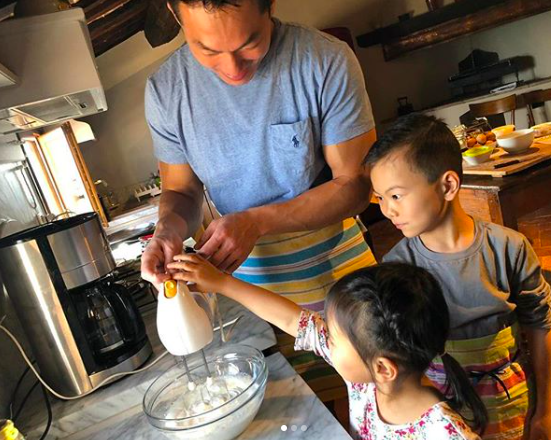
You may not realize it, but you probably experience mental fatigue on the regular. Just be aware of this, take steps to counteract it, and do your best — for yourself and your kids — to uphold the boundaries and behavioral strategies you want to maintain with your children.
4. Model the behavior you want to see
Little children are masterful imitators; they echo what they see and what they experience.
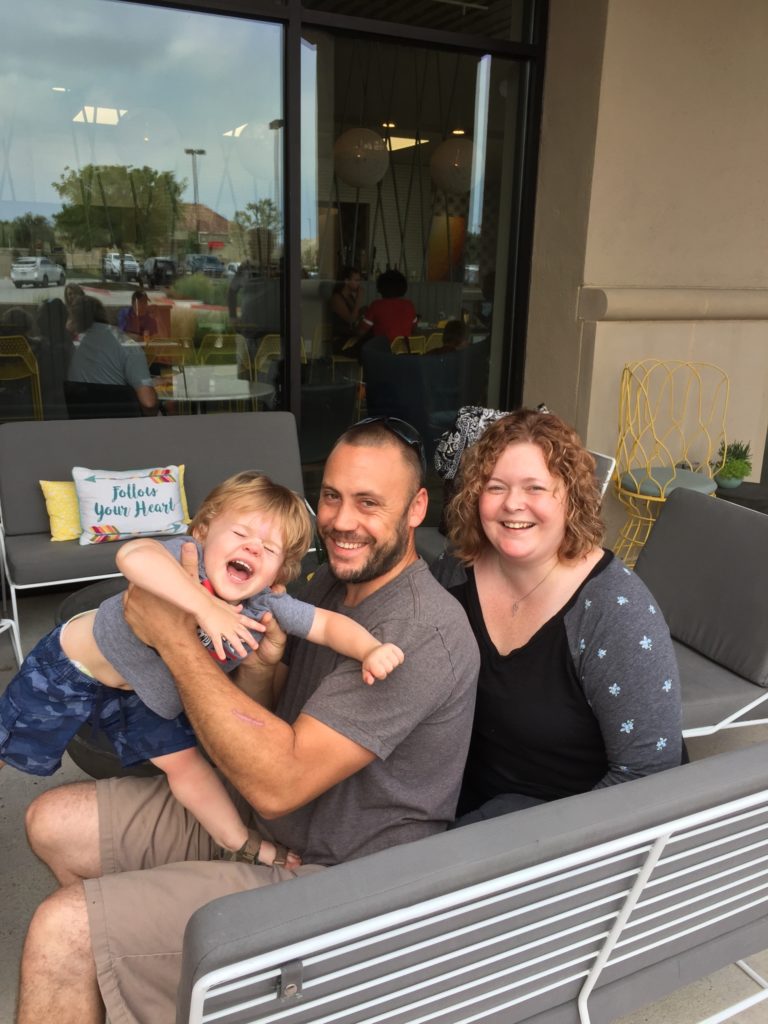
We have to take a look in the mirror and observe our own behavior. Even in the chaos of day-to-day life with young kids, we should try to project the calmness, generosity, patience, kindness, and manners we want our kids to absorb.
We know this is a lot to ask (just be perfect!!), but it goes such a long way, and you can take baby steps or focus on one thing at a time. For example, demonstrate what your children can say when they’re upset by describing your own feelings, e.g. “I’m sad!” or “I’m frustrated….” Say “please” and “thank you.” Share.
It’s also super important to follow your own rules (or make it look like you are – HA). I’m frequently reminded to do this myself when my son reprimands me: “Mama, we don’t wear our boots in the house”; “Mama, if you want to eat something you need to sit down at the table!”; “Mama, if you want me to come with you, you need to say please!”
It’s really so humbling!
On the flip side, modeling also means avoiding behaviors we want to minimize. Flipping people off in traffic, for example. The biggest hiccup here tends to be… drum roll, please… losing your temper.
WE ALL DO IT. And if you’re anything like me, you swear you’ll never do it again (sigh). Yes parents, it is very hard not to ever lose your temper, but it’s a skill you can cultivate. At the end of the day, losing it by grabbing things from your child, yelling and screaming, snapping, saying hurtful things, and spanking are really just adult versions of a temper tantrum. Right?
We find we’re especially vulnerable to losing it when we’re feeling rushed, which leads us to:
5. Build in more time. For everything.
We cannot underscore this enough:
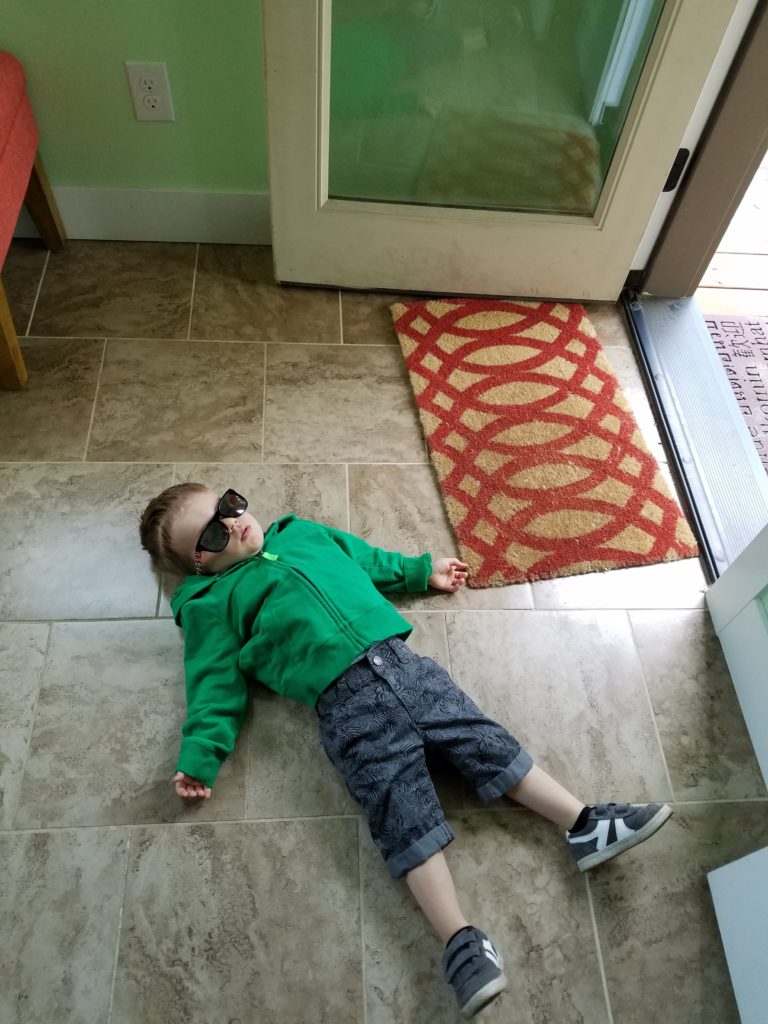
Something will always come up (another diaper change, an epic spit-up, a tantrum, forgetting the lunchbox, someone wants to wear a different pair of shoes with an impossible set of laces, etc.).
For real, folks: allotting more time for all your routines will make you precisely 200% happier.
And if you’re the type (like us) that gets stressed when you’re late for something, this is even more important for you.
So maybe the younger, non-parent version of you could make it from home to the store in exactly 12 minutes, but the new you has to double this time estimate. Yes, it’s a tough pill to swallow, especially if you’re the type who prides yourself on time efficiency.
Alas.
I had a wake-up call on this when, after rushing to get my son into his car seat one particularly hurried morning, he sweetly looked up at me and said: “Mama, you’re not angry?” My heart melted. Lesson: our kids can sense when we’re flustered, frustrated, and upset. The flip side of this is that our kids can also sense our love. Although it’s difficult, it can really help to zoom out in these frantic moments and think big picture: what’s the hurry?
As a solution, we try to set earlier times for everything. If we need to be out of the house at 7:15, we’ll call it 7:00. If there’s a birthday party starting at 3:30, we’ll shoot to arrive at 3:15 or 3:20. Building in this extra time makes a huge difference.
Another thing that can help with this is to…
6. Cultivate routines
Rely on routines for your everyday processes.
A great way to get started with this is to work to establish consistent steps for things that happen every day:
- Leaving the house (put on shoes, coat, use the bathroom/change a diaper, etc.)
- Mealtimes (wash hands, get a napkin, sit at the table, etc.)
- Bedtime (bath, PJs, story, etc.)
The most important thing with routines is that everything proceeds in a predictable order — the idea is that the patterns let kids know what they can expect next, which in turn helps them feel more in control and more aware.
Meg still uses this with her 6 and 9 year olds. When leaving the house in the morning, it’s “glasses, lunchbox, shoes.” At bedtime, it’s “brush, jammy, books.” For soccer, it’s “water, ball, shin guards, shoes.” She makes sticky notes with these words to remember the basics.
End result: everything flows better. Sometimes, my son actually offers to go to bed at night because he knows bedtime “comes next” after his dinner, multivitamin, brushing, and pajamas. #parentingwin.
And as you go about your routines, do yourself another favor:
7. Share control when you can
By that, we mean: try to offer your children two clear choices as often as possible.
Kids like to have some sense of control, and a really slick way to give this to them is to offer them choices wherever you can (even if they are ridiculously unimportant).
Two choices is ideal — any more than that and it’s overwhelming. (You can start doing this as early as 1 year of age!) The gist with this strategy is that for anything you need to accomplish, such as putting on shoes, you can frame the direction as an option. In this case: Do you want to wear sandals or tennis shoes?
Here are some more examples: Do you want the red cup or the green cup? Bowl or plate? Mickey PJs or dinosaur PJs? Grapes or strawberries? Bedtime story or song? Goodnight Moon or Wild Things? Climb the stairs or be carried up the stairs to bed? Get ready to leave now or in 5 minutes? Put on your shoes first or go potty first?
You get the idea: for all the things that need to get done, offer kids a choice. Remember to keep it simple and make it a clear-cut statement, not a pleading request.
A or B.
* Note that one-year-olds might not be the best decision-makers; they may struggle a little to actually make a selection, but it doesn’t hurt to start getting in the habit of offering options anyway. Two- and three-year-olds will love making decisions and being in control, and that’s where you’ll really start to see some benefit to this proactive method.
8. Pile on the praise
Deliver LOTS of praise and positive enforcement, even for things you expect. Once you start paying attention, you’ll probably notice that you can deliver praise for ANYTHING. Don’t worry about over-praising your toddler — there’s a ton of great work indicating that over-praising school-aged children can sometimes backfire, but all the experts agree: gushy, over-the-top-praise with young children is A-OK.
Here are some research-backed tips to maximize your results with this:
- praise precisely — research shows that praise is most effective when it’s very specific. For example:
- instead of “good job,” try: “I really like how you’re holding my hand while we walk on the sidewalk.”
- instead of “thanks,” try: “thank you so much for bringing your plate over to the sink when you finished eating.”
- instead of “nice work,” try: “wow! That is so great how you’re sharing your trains with your sister!”
- praise behavior and effort over personality — focus on actions and “trying.” I.e.:
- instead of “you’re so smart,” try: “I can see that you worked so hard on this!”
- instead of “you’re so helpful,” try: “great work helping me clean up the toys!”
Speaking of which,
9. Choose your words
Words matter. Be aware and purposeful with how you speak to your child. Here are some quick tips on this:
- Reframe commands into choices or “deals,” i.e.:
- instead of “calm down,” try: “we can go for a walk as soon as you are quiet and calm down.”
- instead of “sit down,” try: “we can have dinner as soon as you get in your chair.”
- instead of “put on your pants,” try: “it’s time to get dressed. Would you like to wear jeans or leggings?”
- Reframe a “no” into a conditional “yes.” i.e.:
- instead of “no, we can’t go play outside,” try: “yes, we can totally go outside this afternoon, after you have some rest!”
- instead of “no whining” or “stop whining,” try: “I’ll be able to hear you when you use your big kid voice.”
- instead of “no running,” try: “please walk with me…” or “please use your walking feet and we can run when we get to the park.”
- instead of “stop giving your food to the dog,” try: “that food is for Abby. If you can keep your food, we can give the dog her own treat after you finish!”
- For even more ideas, check out this Love & Logic chart.
- Avoid making requests for things that need to happen — when we ask our children if they want to do something, we are opening the door for them to say, “No!”
*This^ is actually a really tough adjustment to make. As adults, we are in the habit of politely asking one another (other adults) questions instead of making demands when we want something: Can you bring this outside? Should we eat now? Could you hit snooze again? Breaking this habit — speaking more bluntly to children instead of passively — will seriously improve your communication with your toddler (and everyone else!).
- When you are asking, ask for help — toddlers absolutely love to help and be helpful, so frame what you need them to do as they’re helping you. (Bonus — international research and cross-cultural data show that fostering toddlers’ desire to help sets the stage for them to willingly contribute to household chores when they hit school age.) [See also: Stop Doing Everything for Your Kids]
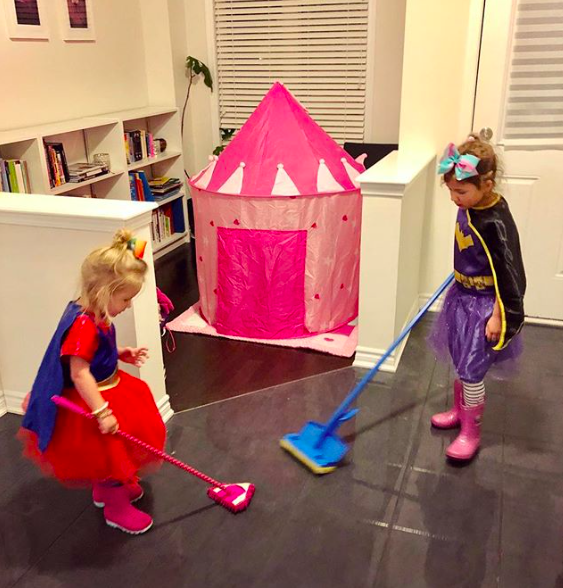
- I.e.: “I need some help putting all these books back on the shelf!”
- I.e.: “could you help me get ready for our walk?”
Here are some “don’ts”:
- Don’t make general commands you cannot enforce, like “be quiet” or “stop that” or “stay still.”
- Don’t repeat yourself. Warning children multiple times, calling for them over and over again, or reminding them of something repeatedly teaches children that they only have to listen when they want to. (You might have heard this same advice when you were training your puppy, LOL.)
- Don’t send mixed messages:
- If you’re upset or serious, use a firm voice, not a sweet one.
- Don’t use sarcasm… I’m thrilled to tell you that experts unanimously agree that using sarcastic language with young children will backfire. Great. Just great.
If you’re still with us — congratulations! Just two more principles to go. Pat yourself on the back for taking the time to reflect on all this. Hopefully you’ve noticed some themes: consistency, empathy, composure, firmness, respect.

If you’ve noticed, everything here is all about us as parents. These are all things we can set up and control — yay! Disciplining ourselves is, well, punishing (pun intended).
*But* we saved the best, most crucial two practices, for last…
Perhaps the ultimate discipline best practice is this:
10. STAY. CALM.
If you followed no disciplinary advice whatsoever, simply staying calm would carry you pretty far — remaining calm is the bedrock of all things discipline.
Why?
Because being reactive does the exact opposite of what we want: it models poor behavior and a lack of self-control on our part.
Even more, being reactive makes children feel powerful (if not downright entertained) and brings emotion into an interaction where it is best left out.
When children get a reaction from an adult — ANY reaction, even if it’s negative — they often feel (too) strong and influential and become more likely to repeat the problematic behavior.

So don’t give them that — take away that tool.
When we can stay calm, we deny our children the opportunity to press our buttons over and over again. NOT being reactive stops that cycle dead in its tracks.
The thing is, when we lose our tempers, we impact our kids’ learning process. Being conscientious, responsive, intentional, patient — these things set the stage for positive interactions and learning. Do you see Supernanny yelling, screaming and having a fit? No, she’s calm, cool and deliberate. And her methods work.
As physician Robin Berman explains (in Permission to Parent), “exciting neuroscience research shows that if we parents can model calmness when our emotions are running high, we teach our kids to manage their emotions.” In staying calm, we teach our kids to regulate their own emotions in difficult moments.
Plus, when we stay in control and don’t react, we have the added benefit of letting our children experience (and learn from) their mistakes. And letting things play out — allowing natural consequences to unfold — can be a great teaching tool.

Have you committed these disciplinary sins and are now wondering if it’s too late to give yourself a do-over? I’ll be the first to tell you: don’t worry — we’ve all lost our cool in the heat of the moment.
Secondly, it’s never too late to change the way you respond to your toddler’s behavior. Do you feel like you’ve been “doing it wrong?” It’s okay!
Sure, you may get some resistance at first. After all, it takes time to build trust as you create new ways of interacting. But in the long run, your child is likely to mirror your evolution. Plus, you’ll be leading by example: be vocal about the fact that you are trying to change; if you slip and go back to your old ways, acknowledge it and get back on track. You WILL mess up along the way and that is okay.
Lastly, don’t neglect to….
11. Take care of yourself
So often, parents think self-care is selfish — how could I possibly devote time to myself when my kids/spouse/pets/parents/neighbors/3rd cousin twice removed, etc. need me to focus on them right now? We tend to throw ourselves on the back burner while we spend countless hours taking care of everyone else around us.
And then? We burn out. We become snappy, frustrated, and resentful. Bitter, even.
But here’s the thing: if you aren’t taking care of yourself — really giving yourself what you need — you simply won’t be able to take care of anyone else (at least not well or calmly, anyway).
I love the simplicity of this statement: The best thing you can do for your child is to take care of you. For those of you who grew up with a parent with an untreated addiction or mental illness, you especially know this is true. Having a healthy, happy parent is 90% of the battle. Look: little kids don’t need music lessons, ballet, or Pinterest-worthy birthday parties. If those types of things are making you crazy, throw them right out the window.
The truth is — as modern parents, we have the craziest demands placed upon us, do we not? We, as a culture, are in a very strange place in our evolution: we’ve lost our villages and communities, many of us don’t have family nearby, most of us have 2 parents that work full-time and all childcare is farmed out to 3rd parties. Without getting sidetracked, the point is that this is not how we evolved to live (say it louder for the people in the back!).
THIS IS NOT HOW WE EVOLVED TO LIVE.
And yet? Here we are. Doing the best we can.
So hear this, parents: self-care is NOT selfish. It’s MANDATORY! Instead of getting up on Saturday morning to take your toddler to tae-kwon-do (which I assure you he doesn’t care about), take that time for yourself and go for a run. Get a latte. Read a paper. Try to find a little peace in yourself.

Self-care looks different for everyone. It doesn’t have to be a crazy, expensive day at the spa. Some people recharge by spending time outdoors and in nature, others by hitting up weekly happy hours with friends, some by working out, and others by sitting alone in a quiet room for 5-10 minutes a day. The point is, it’s not WHAT you do, but rather figuring out what fills you up mentally, physically and emotionally, and then doing those things. With zero guilt. In fact, just pretend it’s your job.
For us, a daily workout and a solid night’s sleep are MUSTS. Without these, we are bears (as our families can attest…) and certainly not as able to stay calm and react appropriately when our children are misbehaving or testing limits.
Of course, life gets in the way, and it’s not always possible to get our needs met every single day. That’s okay. But trust me, the entire family will benefit from happier, healthier, and more personally fulfilled parents.
We know this was a LOT. You can use our printable (see below) as a cheat sheet to help you stay on track. Remember that “discipline” is more about teaching and everyday life than it is reacting, and that a surprising amount of managing toddler behavior actually entails managing ourselves and our environments.
In our next piece, we’re going to get our hands dirty and delve into the nitty-gritty details on some of the best ways to respond when all your best practices fall to pieces (or fail) and things hit the fan. Stick with us! You’re doing great!
~
**One of the best ways to help enact and practice these mantras is just to keep them in mind. Think of them often. Remember them throughout the day. Try printing out this Best Practices Recap and keeping it somewhere prominent — your fridge, your desk, your car dashboard — so you can view it daily. Everything here boils down to the ultimate goal of preventing problems before they arise. (Oh yeah, and enjoying your family.)
1. Childproof Your Space
2. Establish Firm Limits
Pick the things that are important to you, and set clear boundaries for what’s acceptable.
3. Stick By Your Word
Follow through with your own rules regularly. Be consistent and be predictable.
4. Model Desirable Behavior
Be calm, be kind, be patient, be generous. Show your kiddo what being a good family member and community member looks like. (Hey, no one said it was easy.)
5. Build More Time
Assume everything will take you longer than planned, and plan accordingly.
6. Cultivate Your Routines
Develop them, grow them, love them, live them.
7. Share Control
Help kids feel some control by letting them make decisions about everything you don’t care about.
8. Pile on the Praise
You got it!
9. Choose Your Words
Remember that you’re not speaking to an adult, and be mindful of the ways your words can influence your interactions with your child.
10. Stay Calm
Maintain your composure — slow down. Breathe, mama.
11. Take Care of Yourself
Practice your own brand of self care. Every day.
It’s a lot, I know, but it’s never too late to start becoming the smarter, calmer parent you’ve always wanted to be. Leave us a comment below and let us know how it’s going.
Cheers and good luck!!
Thank you! This is a brilliant recap of lots of literature on discipline. I’m a middle school teacher and the principles apply to good classroom management too. I almost want to share this with my mentee teachers.
I am a Nanna responsible for my 3 year old grandson. I went through being a mother 30 years ago and here I am again. It is different, difficult with feeling unsure if I’m doing the right thing. You helped me with the information I read and will invest more time in reading your reassuring information.
Thanjs so much!
wonderful, thanks for your support! Much appreciated – Meg